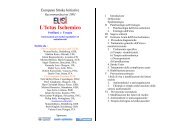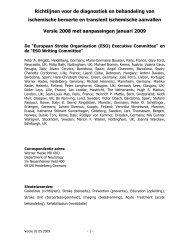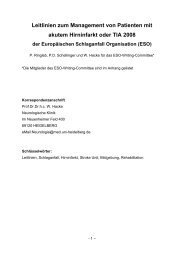Guidelines for Management of Ischaemic Stroke 2008 - ESO
Guidelines for Management of Ischaemic Stroke 2008 - ESO
Guidelines for Management of Ischaemic Stroke 2008 - ESO
You also want an ePaper? Increase the reach of your titles
YUMPU automatically turns print PDFs into web optimized ePapers that Google loves.
<strong>ESO</strong>-<strong>Guidelines</strong> <strong>for</strong> <strong>Management</strong> <strong>of</strong> <strong>Ischaemic</strong> <strong>Stroke</strong> <strong>2008</strong><br />
Patients with widely varying brain pathology may present with transient neurological<br />
deficits indistinguishable from TIA. CT reliably detects some <strong>of</strong> these pathologies<br />
(e.g. intracerebral haemorrhage, subdural haematoma, tumours) [129], but others<br />
(e.g. multiple sclerosis, encephalitis, hypoxic brain damage, etc.) are better identified<br />
on MRI, while others (e.g. acute metabolic disturbances) are not visible at all.<br />
Intracranial haemorrhage is a rare cause <strong>of</strong> TIA.<br />
Between 20-50% <strong>of</strong> patients with TIAs may have acute ischaemic lesions on DWI<br />
[144, 188, 189]. These patients are at increased risk <strong>of</strong> early recurrent disabling<br />
stroke [189]. However, there is currently no evidence that DWI provides better stroke<br />
prediction than clinical risk scores [190]. The risk <strong>of</strong> recurrent disabling stroke is also<br />
increased in patients with TIA and an infarct on CT [191].<br />
The ability <strong>of</strong> DWI to identify very small ischaemic lesions may be particularly helpful<br />
in patients presenting late or in patients with mild non-disabling stroke, in whom the<br />
diagnosis may be difficult to establish on clinical grounds [130]. T2*-MRI is the only<br />
reliable method to identify haemorrhages after the acute phase, when blood is no<br />
longer visible on CT [143].<br />
Other diagnostic tests<br />
Recommendations<br />
In patients with acute stroke and TIA, early clinical evaluation, including<br />
physiological parameters and routine blood tests, is recommended (Class I,<br />
Level A)<br />
For all stroke and TIA patients, a sequence <strong>of</strong> blood tests is recommended (Table<br />
3, Table 5)<br />
It is recommended that all acute stroke and TIA patients should have a 12-lead<br />
ECG. In addition continuous ECG recording is recommended <strong>for</strong> ischaemic stroke<br />
and TIA patients (Class I, Level A)<br />
- 26 -





